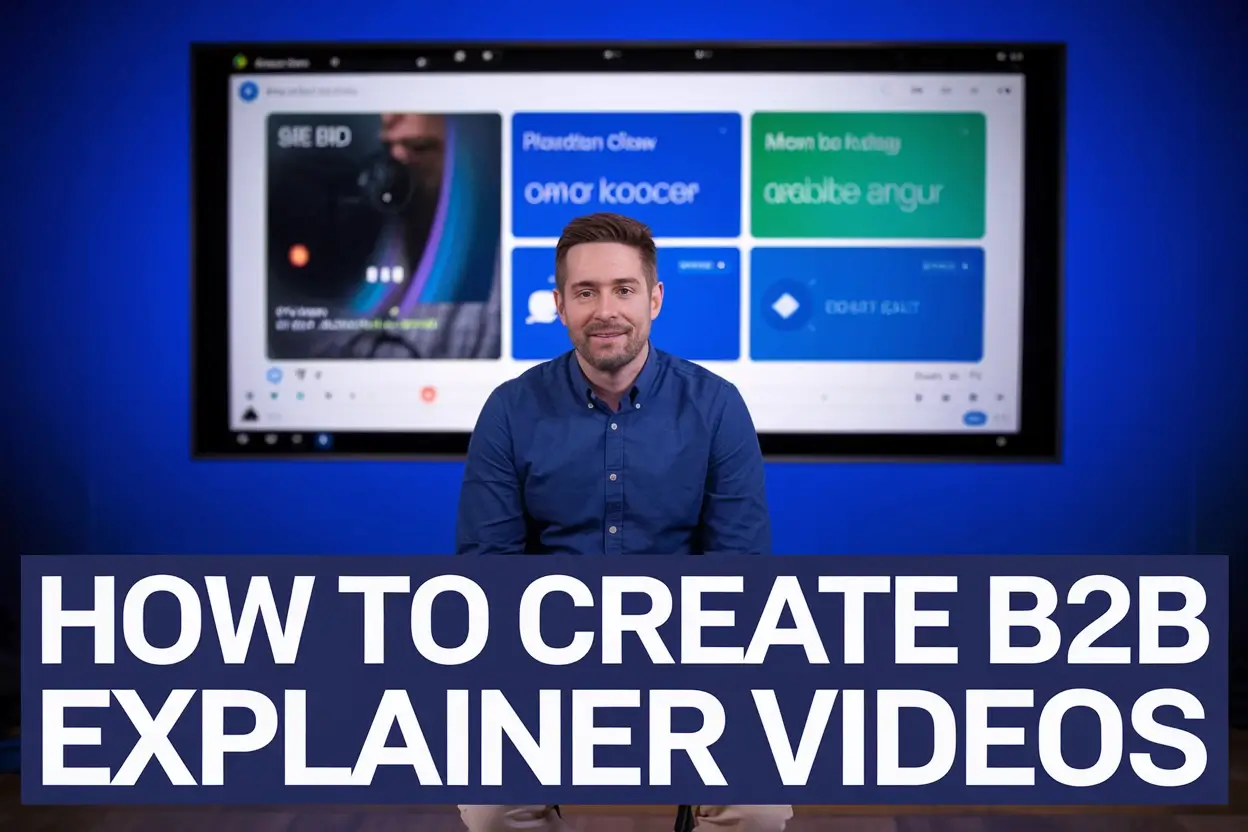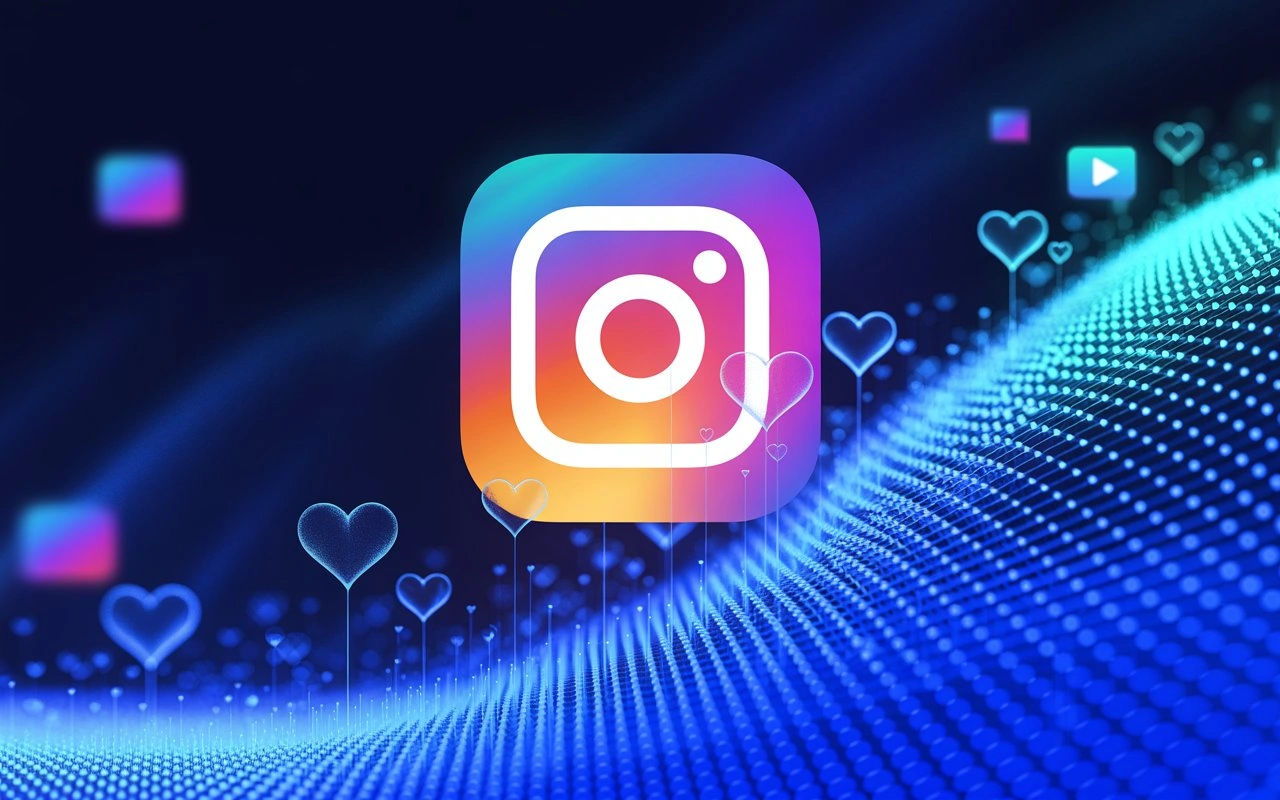Table Of Content
Creating impactful B2B explainer videos is more art than science, but when done right, they can be game-changers.
Why?
Because today’s B2B buyers crave simplicity.
They’re just as emotionally driven as B2C buyers. Think about it — when was the last time you made a big business decision without a gut feeling?
Moreover, studies show that 73% of people prefer to watch a short video to learn about a product or service, compared to reading text. That’s massive!
And businesses using video grow revenue 49% faster than those that don’t.
These stats tell us one thing loud and clear—explainer video isn’t just a nice-to-have—it’s a must.
From my 10 years of crafting videos that move the needle, I’ve learned one crucial thing: effective B2B explainer videos don’t just explain—they PERSUADE.
They solve real problems, tell captivating stories, and do it all in under two minutes. And the best thing is, with AI tools, making these videos is easier than ever.
No Hollywood budget is required!
That’s why in this guide, I’ll break down the process step-by-step to make b2b explainer videos, covering scriptwriting, tips, ideas, and tools.
So, grab your coffee and read this comprehensive guide about how you can create videos that close deals and leave a lasting impression.
Why Are Explainer Videos So Effective for B2B?
Explainer videos are effective for B2B because they break down complex products or services into simple, digestible information that decision-makers can quickly understand.
Let’s say you sell a software solution for managing customer relationships. Instead of reading through a bunch of text to figure out how it works, an explainer video can show exactly what the software does in action.
It walks your audience through the problem, the solution, and the benefits—all in just a couple of minutes.
Moreover, explainer videos also make your brand feel human. When you use real people, relatable language, or even a friendly animated character to explain your product, it builds trust.
Decision-makers want to feel like they’re dealing with a company that understands their needs and is genuinely trying to solve their problems.
A well-crafted video can convey that in a way that feels personal and that leads to higher engagement and a 20-30% increase in conversions for B2B sales teams.
Below I have shared some of the most common types of B2B explainer videos that you must know as a business owner.
Common Types of B2B Explainer Videos

With 82% of B2B businesses using explainer videos, they’re like the Swiss army knives of B2B marketing—flexible and ready to tackle a range of challenges. But not every video is the same.
Depending on your business goals and the questions your audience has, the right video can make all the difference.
Let’s take a look at the types of explainer videos and why they’re so powerful in building trust, sparking interest, and driving real results.
Product Demos
Product demos are the bread and butter of B2B videos. Why? Because seeing is believing. A polished demo video can showcase your product’s features and benefits far better than any brochure or presentation ever could.
Imagine you’re launching a SaaS platform. Instead of overwhelming your audience with technical specs, a 2-minute demo can walk them through how your software simplifies tasks and saves time.
I once worked on a product demo for a CRM tool. By highlighting a single feature—automated lead scoring—we saw sign-ups jump by 40% in a single quarter.
Check out how Leadjet perfectly nailed the product demo, clearly showing how it works and the incredible benefits users can gain.
Pro tip 💪
Start with a common pain point and show exactly how your product eliminates it. End with a clear call to action, like booking a free trial.
Onboarding and Training Videos
Onboarding and training videos are lifesavers for both your clients and your support team.
These videos help new customers hit the ground running while reducing the need for lengthy onboarding calls.
And here’s a twist…
Training videos aren’t just the how-tos.
Add a bit of storytelling or humor to make them more engaging and less of a chore to watch.
Check out the Nordstrom training video:
Industry Case Studies and Success Stories
B2B buyers love proof. Case studies and success story videos give them exactly that. They’re your chance to spotlight real customers and tangible results.
See how Canva effectively used a case study to show how it empowers small businesses and non-tech-savvy users to achieve their goals.
Pro tip 💡
- Include data
- Numbers speak volumes.
- Show the measurable results you delivered and pair them with real customer quotes Authenticity is everything
Process and Workflow Videos
These types of videos demystify complex systems. They’re perfect for industries like manufacturing, IT, or supply chain management.
Think about it: wouldn’t you rather watch a clear, visual walkthrough of a process than read a 20-page manual?
One IT firm I worked with used a video to explain their cloud migration process.
By visually mapping out the steps, they closed deals faster because prospects instantly understood how seamless the transition would be.
Moreover, these videos shine when paired with animation. Charts, graphs, and step-by-step visuals keep things clear and engaging.
In addition, I recommend you highlight key steps while keeping it simple.
Don’t overwhelm viewers with every detail—focus on the parts that matter most to your audience.
FAQ and Troubleshooting Videos
FAQ and troubleshooting videos are the unsung heroes of customer experience. They’re proactive and show your audience you care about their time.
Take an e-commerce platform, for instance. Instead of making users dig through a help center, a quick video answering common setup questions can work wonders.
I’ve seen businesses cut their churn rate by creating a library of troubleshooting videos. The key? Keep them short and to the point.
Bonus tip 🔥
Use AI tools to create these videos faster. Zebracat is a text-to-video AI-powered tool that can turn a blog post or FAQ list into a polished video in minutes.
Key Elements of a Compelling B2B Explainer Video

Creating a B2B explainer video that stands out is like having a heart-to-heart chat with your audience. It should feel personal, engaging, and impossible to ignore.
Picture this: in a sea of information overload, your video is the one message that makes someone pause and say, “Oh, I get it now!”
A great explainer video isn’t just extra content; it’s your golden ticket to leave a lasting impression. So, now let’s break down what makes these videos so powerful and how you can nail every key element.
Clear and Concise Messaging
No one has time for fluff, especially in B2B. Your messaging should be laser-focused on the problem and how your solution solves it.
Keep jargon to a minimum and stick to plain, clear language.
When I worked on a video for a cybersecurity firm, we condensed a complicated system into a single sentence: “We protect your sensitive data with advanced encryption and security protocols, so you can focus on scaling your business without worrying about cyber threats.”
That clarity made all the difference.
Audience-Centric Content
Your video isn’t about your product—it’s actually about your audience.
What keeps them tossing and turning at night?
Is it delivery delays, inefficient workflows, or tight budgets?
Speak directly to those frustrations. Dig deeper into their daily challenges and show empathy for their struggles. For instance, if your target audience is procurement managers, imagine their stress when suppliers miss deadlines.
A video that acknowledges this pain and demonstrates your solution’s reliability will hit home like no text or ad ever could.
Storytelling and Structure
A good B2B explainer video isn’t a list of facts—it’s a story.
Start with the problem, introduce your solution, and end with the benefits. Think of it like this:
- Hook your audience with a relatable scenario.
- Build tension by showing what’s at stake.
- Resolve it with your solution.
See how Hubspot uses storytelling to start an explainer video.
Moreover, one of the most impactful videos I worked on told the story of a financial services company on the brink of disaster.
Their servers were hit by a ransomware attack, and they nearly lost years of sensitive client data.
The video walked viewers through this high-stakes moment, showing how the cloud storage platform not only restored their data but added safeguards that ensured this would never happen again.
It was more than informative—it gave the audience a visceral understanding of why choosing the right solution could be the difference between success and failure.
That kind of storytelling sticks because it taps into real fears and delivers a clear, relatable resolution.
Strong CTA
A great video leaves the viewer with no doubt about what to do next.
Whether it’s “Schedule a demo,” “Download our whitepaper,” or “Start your free trial,” your call to action should be clear, compelling, and easy to follow.
Pro tip 🔥
Place your CTA strategically. The end of the video is the obvious spot, but consider adding a subtle nudge halfway through.
For instance, “Ready to see how this works? Click the link below!” can capture viewers before they drop off.
Quality
Let’s be honest: poor-quality videos don’t just miss the mark—they can actively damage your brand’s credibility.
Imagine this: you’re watching a video with shaky visuals, distracting background noise, or outdated clip art animations. What’s your immediate impression of the company behind it?
It’s likely, “If this is how they present themselves, can I trust their product?” Therefore, invest your time and money to increase the quality of your video.
Best Tools for B2B Explainer Video Creation
After spending countless hours testing and researching dozens of tools for b2b explainer videos, here are the best tools I’ve come across, each offering unique features that stand out depending on your needs.
1. Zebracat

Zebracat is an emerging tool designed to simplify explainer video creation with AI-driven automation. It’s a perfect choice for businesses that need quick turnaround times and automated video creation with minimal manual effort.
I recently used Zebracat for a marketing campaign targeting SMBs. Its AI-generated voiceovers and customizable templates allowed us to produce three videos in one afternoon, cutting production time by 70% compared to traditional tools.
Pros
- Extremely time-efficient.
- Ideal for multilingual audiences.
- Intuitive interface for non-technical users.
Cons We Work On:
- While Zebracat’s AI-driven design makes it quick and easy to create videos, we know that sometimes you want more control over the finer details. That’s something we’re actively working on.
We’re focused on rolling out more customization options soon, so you’ll have even more freedom to express your creativity while still enjoying the simplicity Zebracat offers
2. Adobe Premiere Pro

Adobe Premiere Pro is the gold standard for professional video editing. It’s designed for businesses that need advanced control over every detail of their explainer videos.
This tool is perfect for creating videos with layered effects, precise color grading, and dynamic transitions.
Pros
- Professional-grade editing capabilities.
- Supports 4K and higher resolutions.
- Robust features for collaboration and workflow management.
Cons
- High cost for a monthly subscription.
- Steep learning curve for beginners.
3. Animaker

Animaker is a fantastic tool for creating animated explainer videos. It’s especially great for B2B companies in industries like IT or finance where abstract concepts need visual clarity.
Pros
- Highly beginner-friendly.
- Affordable pricing tiers.
- Wide variety of animation options.
Cons
- Limited advanced animation tools.
- Customization options can feel restrictive.
4. Final Cut Pro

Final Cut Pro is Apple’s flagship video editing software, designed for professionals seeking high-end features with a sleek user experience.
Pros
- Superior performance on Mac devices.
- Advanced features for professional-grade output.
- One-time purchase with no subscription fees.
Cons
- Limited compatibility with non-Mac systems.
- Requires significant expertise for advanced features.
Steps to Create a B2B Explainer Video that Converts

Creating a B2B explainer video is an art and a science.
Done well, it doesn’t just inform – it convinces.
Let’s break it down step by step so you can craft a video that gets results.
Step#1: Research and Scriptwriting
The backbone of every great explainer video is its script. Think of it like the blueprint of a house. Without a strong foundation, nothing else will hold up.
You can start by defining your audience's personas.
- What roles do they play in their companies?
- What challenges keep them awake at night?
- Who makes the purchasing decisions?
- What metrics do they care about?
In B2B, it’s often about ROI, efficiency, or risk reduction. You can use CRM data, surveys, forums, or industry reports, to identify pain points. Your video script needs to answer unasked questions proactively, making it more than just a sales pitch.
Also, make sure to write for humans and validate for algorithms. That means using a conversational tone and integrating search intent.
For example, keywords like “automated CRM solutions” can organically fit within compelling narratives without sounding forced.
Step 2: Storyboarding and Visual Planning
Planning visuals is where ideas transition into execution. Storyboarding is the process of visually organizing your script to make sure the video flows logically and captivates your audience.
From making a lot of mistakes I have learned that the storyboarding process should be started by plotting each scene’s purpose—what message should it convey?
Include notes on transitions, pacing, and where key text or icons will appear. For example, highlight the exact second when a call-to-action should flash on-screen to grab attention.
For visual planning, prioritize consistency in your brand’s colors, fonts, and overall aesthetic. Create a visual hierarchy—what elements should grab attention first? For instance, bold text for key stats and softer tones for secondary details.
I also suggest you to experiment with movement. Subtle animations can guide the viewer’s eye, while static visuals can emphasize moments of clarity.
Moreover, studies show that viewers often decide whether to continue watching a video within the first 30 seconds. If they are not engaged by then, they are likely to click away. Therefore, try to frontload impactful information.
That way you can create invaluable content for your audience that exactly meets their needs and expectations.
Step #3: Selecting a Video Style
Here’s where many businesses go wrong—picking a style that doesn’t match their brand. Animated? Live-action? Whiteboard? The choice should align with your product and audience:
- Animation – Great for explaining complex tech or abstract ideas.
- Live-action – Perfect for showcasing people or physical products.
- Whiteboard – Ideal if you’re working with tight budgets but still want engagement.
One mistake I learned the hard way?
Using too many styles in one video. It confused the audience and diluted the message.
Stick to one, and own it.
Step #4: Production and Animation
Lights, camera, action—but with a twist. Even in production, keep the focus on your message with these essential steps:
- No clip should drag on. You’re here to inform, not bore.
- Use branding elements. Add your logo subtly and stick to your brand’s color palette.
- Choose a clear voiceover. A warm, relatable tone works wonders in building trust.
However, if you’re camera shy and don’t want to spend too much time on video content creation Zebracat AI is here to help.
Its AI-driven script-to-video generator creates your explainer video in minutes—no need to step in front of the camera.
From animations to voiceovers, it streamlines the entire process so you don’t need to focus on the technical details. Here’s the complete breakdown of how to use Zebracat script to video generator to make your b2b explainer videos.
- Create your Zebracat account and "Create Video" to begin the video creation process.
- You’ll be presented with four different video types. Select the one that best suits your B2B needs.

- Now choose your video visual style, like realistic or animation, etc. If you have your own visual preferences or branding, you can also upload custom graphics or illustrations.

- Select "Script Input" as the input type. In the script box, paste or type the script you’ve prepared for your B2B explainer video.

- Choose the video ratio based on where you plan to share the video (e.g., square for social media, widescreen for website embedding).
- Select the language. Zebracat supports multiple languages, so you can create videos in the language your target audience prefers.
- Adjust the mood to reflect the tone of your business (e.g., professional, friendly, energetic, serious).

- Once everything is set, hit the "Generate Video" button. Zebracat will process your script and video preferences, and in just two minutes, your B2B explainer video will be ready for review.
- Once your video is generated, preview it to ensure it matches your expectations. If needed, make adjustments to the script, visuals, or mood. You can easily re-edit the video to fine-tune details.
Step #5: Editing and Post-Production
The magic happens here. This is where your raw footage or animation gets polished. With said that I have shared my editing process you can follow too.
- Aim for 90 seconds video or less. Longer videos risk losing attention, especially in the fast-paced B2B space. Analyze your footage and remove anything that doesn’t serve the core message—brevity boosts clarity and impact.
- Add captions. Did you know that 85% of people watch videos on mute? Captions aren’t optional—they’re essential. Clear, concise captions ensure accessibility and keep your message intact, no matter where or how people watch.
- Optimize for platforms. Different platforms demand different formats. For example, Instagram thrives on portrait videos for mobile-friendly scrolling, while YouTube’s widescreen format is ideal for a cinematic experience. So customize your video to maximize its effectiveness on each channel.
Pro Tip ⚡
Zebracat can simplify this process dramatically because using it you can edit your videos even if you don’t have prior video editing experience.
B2B Explainer Video Styles: How to Pick the Right One
Choosing the right style for your B2B explainer video can make or break its impact. Different styles are for different audiences, and understanding their strengths makes sure your message hits home. Let’s break down the options.
Animated Explainers
Animated explainer videos are a go-to choice for B2B companies when dealing with abstract or intricate ideas. Animation makes it possible to visualize concepts like data flows, system integrations, or futuristic technologies that live-action can’t effectively portray.
Why Choose Animation?
- Perfect for industries like SaaS, IT, and finance.
- Highly engaging and adaptable to different styles.
- Can be customized to match your branding.
Challenges
- Requires skilled animators for high-quality output.
- May lack the human touch of live-action.
Live-Action Videos
Live-action videos add a personal, human touch to your brand that’s hard to replicate. They’re perfect for showcasing company culture, client testimonials, or product demos.
In these videos, viewers saw genuine emotion and confidence, which can significantly boost your trust and credibility with potential buyers. That’s the power of seeing real people in real settings—it’s instantly more relatable.
Why Choose Live Action?
- Builds trust with authentic, relatable visuals.
- Great for industries where personal connection is key, like healthcare or consulting.
- Allows you to showcase real environments and products.
Challenges
- Higher production costs.
- Requires careful planning to avoid appearing overly scripted or stiff.
Whiteboard and Infographic Videos
Whiteboard and infographic videos are great for B2B explainer content, especially when you need to break down complicated concepts into digestible chunks.
These videos use clean, hand-drawn visuals or graphics to guide you through processes, workflows, or step-by-step instructions in a simple, engaging way.
Why Choose Whiteboard?
- Perfect for educational videos or technical explanations.
- Highly cost-effective compared to other styles.
- Simplifies dense or dry topics.
Challenges
- Can feel repetitive or overly simplistic if not done well.
- Limited visual variety compared to animations.
Screen Recording and Demo Videos
Screen recording videos are ideal for software companies or any business offering digital tools.
By walking viewers through a live demo of your platform, you can highlight features and benefits in real time.
For example, I once worked with a SaaS company that used this style to show off its CRM interface.
We focused on its intuitive navigation and ease of use, which really clicked with prospects. The hands-on approach made the product feel accessible and practical, leading to a 35% boost in trial sign-ups.
Why Choose Screen Recording?
- Great for showcasing software functionality.
- Provides a real-time, practical view of your product.
- Quick and cost-effective to produce.
Challenges
- Visuals can feel static or unexciting without good narration.
- Limited appeal outside of tech-savvy audiences.
Hybrid Videos
Hybrid videos combine the best of both worlds. These videos work because of their versatility. You can explain the technical side with animations and showcase real-world applications with live-action.
Imagine showcasing a factory process—live-action footage of machines running can establish authenticity, while animated overlays can highlight data points or show how the process flows step by step.
Why Choose Hybrid?
- Combines the authenticity of live-action with the flexibility of animation.
- Ideal for industries with complex products or services.
- Keeps viewers engaged with varied visuals.
Challenges
- Requires a higher budget and production expertise.
- Balancing the two styles seamlessly can be tricky.
Best Practices to Craft a High-Performing B2B Explainer Video

A great B2B explainer video isn’t throwing visuals on a screen. It really gives your audience something valuable and keeps them interested the whole time. Below I shared some of the best practices to make high-performing B2B explainer videos. Ready to dig in?
Keep It Short and Focused
Attention spans are short—especially in B2B. That’s why your explainer video should be concise and focused on one core message.
Experts recommend that the ideal length for most videos is between 1 to 2 minutes.
Videos in this range are more likely to hold viewers' attention and convey essential messages without overwhelming them
Therefore, to keep videos short and focused, don’t cram everything into one video. Instead, create a series of short videos if you have multiple messages.
This keeps the audience intrigued without overwhelming them.
Insider Tips
- Use a strong opening to hook your audience within the first 10 seconds.
- Focus on one problem and its solution.
Optimize for Mobile Devices
With video consumption trends increasing, over 70% of decision-makers watch videos on mobile devices.
If your video isn’t mobile-friendly, you’re missing out.
A video that looks great on desktop but awkward on mobile loses credibility instantly. That’s why use bold visuals and large, legible text.
Think about how often someone scrolls through their phone during lunch or on a break. If your video isn’t easy to watch in those moments, you’ve lost them.
Tips
- Use vertical or square formats when appropriate.
- Test your video on various devices for compatibility.
- Keep the CTA buttons or links mobile-accessible.
Prioritize Audio and Visual Clarity
If your video isn’t clear, it won’t convert. High-quality visuals and crystal-clear audio are non-negotiable.
Even minor lapses in production quality can make your video feel unprofessional.
I’ve seen videos fail because background music was too loud, overpowering the voiceover.
Tips:
- Invest in professional microphones and lighting for live-action.
- Ensure visuals are sharp and properly aligned with the narration.
- Add captions for accessibility and better retention on mute.
Maintain Brand Consistency
Your explainer video is an extension of your brand. It should reflect your company’s personality, values, and identity at every level.
Use your brand’s signature colors, fonts, and tone of voice to create a video that feels consistent with your other marketing materials.
Think about it this way: if someone watches your video and visits your website right after, the transition should feel seamless.
Tips:
- Use consistent brand logos and color schemes
- Match video tone with brand voice (friendly vs formal)
- Maintain uniform style across all platforms (web, social media)
Distribution Strategies for B2B Explainer Videos
To effectively distribute B2B explainer videos, embed them on your website’s homepage, product pages, and landing pages; email campaigns targeting decision-makers; and integrate them into webinars, sales pitches, and industry directories.
Leverage SEO, YouTube, and retargeting ads to maximize reach while tracking performance metrics to refine strategies.
Real-Life Examples of Successful B2B Explainer Videos
Let’s explore real-world examples and dissect the specific elements that make these videos exceptional.
1. Dropbox – Simplifying Cloud Storage
Dropbox’s early explainer video remains a textbook example of success.
The video used simple animation to show how Dropbox solved the problem of scattered files.
Instead of listing features, it demonstrated how users could save time and stress by keeping all their files in one accessible place.
Why It Worked?
- The video avoided technical jargon and focused on relatable scenarios, such as forgetting files on a USB drive.
- Hand-drawn animations gave the video a friendly and approachable feel.
- This video played a key role in helping Dropbox acquire 4.7 million views.
2. Slack – Humanizing Team Collaboration
Slack’s explainer video addresses a common pain point: fragmented team communication.
The video walked viewers through how Slack simplified collaboration by bringing all conversations, files, and tools into one platform.
Why It Worked?
- It highlighted everyday workplace frustrations, making the solution instantly appealing.
- The tone, visuals, and script aligned perfectly with Slack’s brand identity.
3. HubSpot – Explaining its CRM
HubSpot’s explainer video introduced the concept of their CRM software by showcasing how it simplifies customer relationship management.
The video demonstrated how HubSpot’s CRM helps businesses organize contacts, track interactions, and automate marketing efforts seamlessly.
Why It Worked?
- Simple visuals and animations underscored the platform’s user-friendly interface which makes it approachable for non-technical users.
- By focusing on time-saving features like email automation and analytics, the video made a compelling case for why businesses should adopt HubSpot CRM.
Common Challenges in B2B Explainer Videos

While impactful B2B explainer video is invaluable for businesses, it’s not without its hurdles. Identifying and addressing these challenges early can significantly improve the final outcome.
1. Overcomplicating the Message
One of the most common pitfalls is cramming too much information into a short video. While B2B audiences often seek detailed insights, videos must strike a balance.
Overloading viewers with technical jargon or excessive data can lead to confusion and disengagement.
Solution
Focus on one core message or problem your product solves. Use additional content like blog posts or whitepapers to dive into specifics for interested viewers.
2. Poor Visuals or Animation
Low-quality visuals or inconsistent animation can undermine your credibility.
Your buyers expect professionalism, and a poorly produced video can reflect negatively on your brand.
Solution
Invest in high-quality production tools or services.
Maintain brand consistency by using your established color palette, fonts, and design elements.
3. Misunderstanding the Audience
Not knowing your audience leads to content that misses the mark.
B2B buyers often have unique roles and goals, like improving efficiency, improving ROI, or ensuring scalability.
A one-size-fits-all approach risks losing their attention.
Solution
Dive deep into research. Identify their pain points, motivations, and decision-making criteria.
Craft your video’s tone and message to speak directly to their priorities.
4. Weak Call-to-Action
A great video loses its impact without a clear next step.
Viewers might enjoy the content but feel lost about what action to take afterward.
Solution
Wrap up your video with a direct, actionable CTA.
For example, encourage them to sign up for a free trial, schedule a demo, or visit your website for more details.
Final Words
The right B2B explainer video can be the difference between a missed opportunity and a closed deal.
It connects, persuades, and inspires action.
Regardless of whether you’re showcasing a product, solving a pain point, or narrating a compelling success story, your videos must relate to your audience on a deeper level.
And no let's be honest. Creating these b2b explainer videos is challenging.
You have to make scripts and storyboards.
Then, there’s the technical side—choosing the right animation, graphics, or live-action elements, ensuring smooth transitions, and matching the tone of the video with the brand’s identity.
However, the good news is that AI tools are making this process far easier.
And one of the best game-changer for me was Zebracat. It can easily transfer your script into a b2b explainer video without a big budget or technical expertise.
And even better, with its AI-generated visuals and voiceovers, you can cut production time in half.
So I encourage you to start making your first b2b explainer video with Zebracat. It’s been my go-to tool for transforming ideas into captivating content—and it could be yours too.
Create videos 10x faster and easier with Zebracat
Try it now









Comments